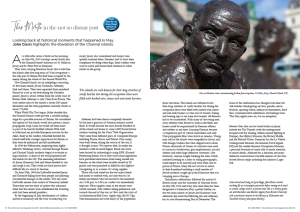Looking back at historical moments that happened in May, John Davis highlights the liberation of the Channel Islands.

At a little after seven o’clock on the morning on May 9th, 1945 warships nosed slowly into the Channel Island’s harbours of St. Helier in Jersey and St. Peter Port in Guernsey.
They were carrying liberation forces that would free the islands after five long years of Nazi occupation—the only part of Britain that had been occupied by the enemy during the whole of the Second World War.
The Channel Islands are an archipelago consisting of five main islands, Jersey. Guernsey, Alderney, Sark and Herm. They were separated from mainland France by a rise in sea level during the Neolithic period. Jersey is about 160km from the south coast of Britain while Alderney is only 15km from France. The total surface area of the islands is about 200 square kilometres and the total population currently stands at about 170,000.
When World War Two began, Hitler decided that the Channel Islands could provide a suitable landing stage for a possible invasion of Britain. He considered the capture of the islands would also present a major propaganda coup. Later, he would see them more as part of his heavily fortified Atlantic Wall, built to withstand any possible European invasion by the Allies. Early in the conflict, Churchill decided the islands held little strategic importance for Britain so they were de-militarised and left undefended.
In 1940 the Wehrmacht, employing their highly effective ‘blitzkrieg’ tactics, stormed through France and Channel Islands residents began to evacuate in large numbers. A third of the total population left the islands for the UK. The remaining inhabitants of Jersey, Guernsey, Sark and Herm decided to stay and tough it out. They could not have known how difficult life was about to become.
On June 28th, 1940 the Luftwaffe bombed Jersey and Guernsey killing forty-four people and inflicting considerable damage on the islands. Two days later Luftwaffe airmen took control of Guernsey airfield. There they met the chief of police who informed them that the islands were undefended-the bombing raids had been entirely pointless.
By the beginning of July, detachments of soldiers arrived in Guernsey and the Nazi swastika flag was raised. Jersey also surrendered and troops were quickly stationed there. Islanders had to show their compliance by flying white flags. More soldiers were soon to arrive and turned their attention to other islands in the group.
Alderney had been almost completely deserted by the time a garrison of German infantry arrived there. It would become the most heavily fortified of all the islands and home to some 4,000 forced labour workers working for the Nazis’ Todt Organisation. They came from different parts of conquered Europe including France, Russia and Poland. Four camps were built where, during the course of the war, it is thought at least 700 captives died. In reality the numbers could be much higher. Burial sites have been located by archaeologists using GPR (Ground Penetrating Radar) but to date strict island regulations have prevented excavations from being carried out. Inmates on the island were brutally treated by SS guards and were punished or killed for the slightest wrongdoing or as a means of saving supplies.
Those who had stayed on the two main islands had much to contend with, not only the loss of family and friends who had moved to the mainland. An 11.00 p.m. to 5.00 a.m. curfew was immediately imposed. What supplies came to the islands were strictly rationed, with soldiers taking preference, and towards the end of the war, in 1944, only the visits of an International Red Cross supply ship, the SS Vega, with humanitarian aid saved many of the population from starvation. The islands are well known for their long stretches of sandy beaches but during the occupation these were filled with barbed wire, mines and anti-tank barriers so were out of bounds. Sailing and boating trips at sea were also banned. All firearms had to be surrendered.
With many of the young men away, children were forced to work in the fields and homes could be requisitioned by German officers and soldiers at any time. Learning German became a compulsory part of school curriculums and only Nazi propaganda films were shown in cinemas. Young men still on the islands were compelled to labour and, with foreign workers that were shipped across from France, thousands of tonnes of concrete were used to construct watchtowers, gun emplacements, air-raid shelters and other large defensive structures. (See footnote). Anyone caught breaking the rules, which included listening to a radio or taking photographs, could expect to be arrested and were often sent to prison in France. Many did not survive to return to their homeland including a small number of Jewish residents caught up in the Holocaust that was sweeping across Europe.
Tumultuous celebrations followed the arrival of British troops and the surrender of German forces on May 9th, 1945 and every year since then has been designated as Liberation Day, a public holiday, on the two main islands of Jersey and Guernsey. Sark celebrates the event the following day and Alderney has its own Homecoming Day in December. The form of the celebrations has changed over-time but still includes thanksgiving services, parades, music festivals, sporting events, military re-enactments, food fairs, commemorative exhibitions and heritage tours. This May, eighty years on, was no exception.
Footnote: Sites that can be visited today on Jersey include the War Tunnels (with the underground hospital used for treating soldiers injured fighting in Europe), the Military Museum, the Battery Moltke and the Peilstad Tower. Guernsey has the La Valette Underground Museum, the German Naval Signals HQ and the smaller German Occupation Museum, a personal favourite of mine with so much attention to minor details. Alderney has a museum and many defensive constructions but little remains of the four forced labour camps including the infamous Lager Sylt.




